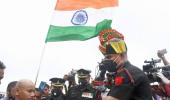'Tibetans will participate in future conflicts with India (in all probability, some were already present in Galwan).'
'As nobody in India would like to have a deadly fight with Tibetan soldiers and officers, the issue needs to be closely followed,' observes Claude Arpi.

Recently, a message circulated on Twitter with the names of the 38 Chinese soldiers who would have died in the Galwan incident on June 15 ('coincidentally', Chinese Communist party Generak Secretary Xi Jinping's 67th birth anniversary).
The tweet has not been confirmed; it might well be one of the hundreds of Information Warfare unverified information going around since the beginning of the standoff between India and China and Ladakh.
What was interesting is that the message also provided the regions from where the purported casualties had come from.
Among them, eight were from Tibet and their names tallied more or less with Tibetan names transliterated in Pinyin (Lakpa, Tsering, Kalsang, etc.).
Once again it could not be verified (something very difficult, next to impossible to do), but the fact that Tibetans are involved near the Line of Actual Control in Ladakh is beyond doubt.
Some knowledgeable sources put the percentage of local Tibetans as high as 10% of the People's Liberation Army soldiers stationed in the Tibet Military District or the Southern Xinjiang Military District. The present 'hot' spots in Ladakh -- Galwan, Hot Springs, Fingers, Depsang -- are under the command of the Southern Xinjiang Military District.
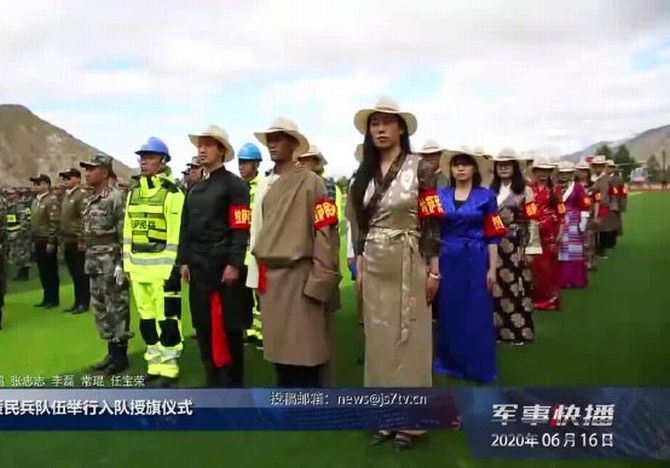
It is extremely worrying that Tibetans are being used by China to fight India.
There is no doubt that the PLA is recruiting local youth to participate in the 'defence of the Motherland' (incidentally, the Tibetans speak of phayul, or 'fatherland'), whether directly under the PLA or border defence forces or even the militia.
News of the recruitment of Tibetans was recently confirmed in an article in 81.cn , the PLA Web site; on June 15, the Tibet Military District held a special flag presentation ceremony for five new militia units, which will work under the PLA; all with Tibetan recruits.
Global Times, the Chinese government owned tabloid, reported: 'PLA Tibet military district and Tibet Autonomous Region held a flag presentation ceremony for 5 new militia units including an air patrol team, polar communication team and extreme climbing team in Lhasa. The duties of the militia units are patrol and emergency rescue.'
Two units have not been named, but a large number of photographs were released.

China Defense Blog commented on the function: 'Personally, I think the phase 'militia' could be a mistranslation, it conjures a negative connotation of a bunch of farmers and their Type56 semi-automatic carbines.
'The Tibetans have their own chopper fleet and air traffic radar sites, providing air patrol as well as S&R [Service and Recovery] operations, not exactly living on rice and beans here.
'They are more aligned with the US 'civilian auxiliary' 'Civil Air Patrol' than the 'people's militia' of the 1960.'
There is no doubt that more than meets the eye.
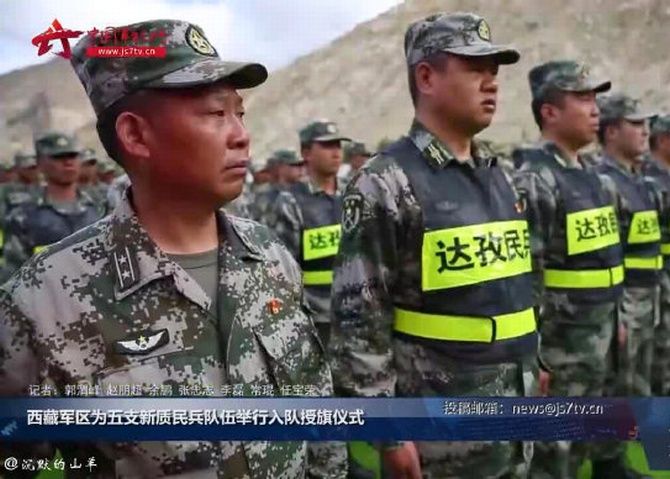
The Militia in China is one part of the armed forces; the other two being the People's Liberation Army and the People's Armed Police.
Under China's Communist party, the Militia serves as an auxiliary and reserve force for the PLA.
China has one of the largest militias in the world, said to be 8 million strong.
According to Article 22 of the Law of the People's Republic of China on National Defence, the Militia, under the command of military organs, shoulders the tasks of preparations against war and defence operations, and assists in maintaining public order.
According to Article 36 of the Military Service Law of the People's Republic of China, the Militia's tasks are:
- To take an active part in the socialist modernisation drive and be exemplary in completing the tasks in production and other fields;
- To undertake the duties related to preparations for war, defend the frontiers and maintain public order;
- To be always ready to join the armed forces to take part in war, resist aggression and defend the motherland.
The militia is organised into regional militia corps in each of the five theatre commands of the PLA; it works under the overall coordination of the National Defence Mobilisation Commission of the Central Military Commission, which can order the deployment of its personnel during peacetime and wartime, if and when ordered by the CMC's Chairman (presently, Xi Jinping).
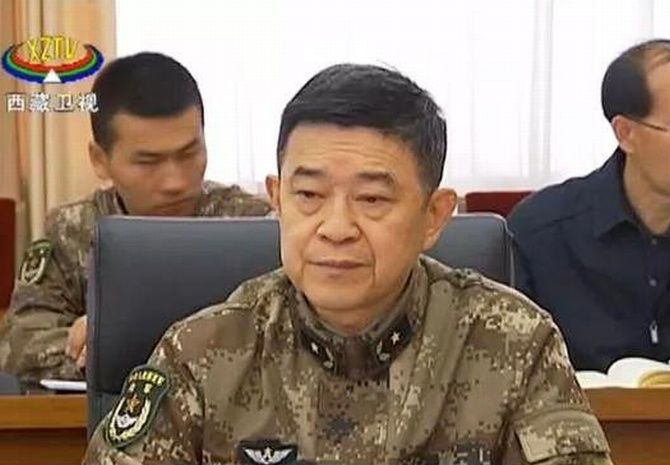
The Tibet Military District's special flag presentation ceremony was presided over by Lieutenant General Zhang Xuejie, the TMD's Political Commissar.
General Zhang is one of the two senior-most PLA officers based in Tibet, along with Lieutenant General Wang Haijiang, the TMD Commander. The TMD faces India's northern borders, particularly Sikkim and Arunachal Pradesh.
In 2018, then Major General Zhang was promoted and transferred to Tibet to take the vital post of Political Commissar; a year ago, Zhang was promoted to lieutenant general.
In 2016, the TMD was upgraded to a sub-theatre unit, directly under the PLA Army or Ground Force (PLAGF).

The Chinese government has obviously decided to integrate more Tibetans into its defence forces; to start with, in the paramilitary forces, giving them good salaries and buying their fidelity.
The Political Commissar's presence at the ceremony means that the recruitment of Tibetans is part of Beijing's 'political work' to stabilise Tibet... as well as the borders with India.
This could have serious implications for India which is fighting a battle in the Himalayas for an imaginary Line of Actual Control, which Beijing has systematically refused to define.
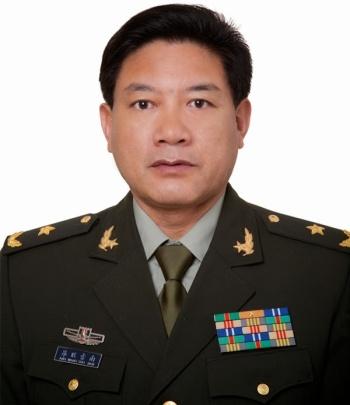
IMAGE: Major General Ngawang Sonam, a Tibetan officer who is presently a deputy commander in the Tibet Military District.
Photographs from the event show Che Dalha standing behind General Zhang.
Che Dalha, a Tibetan leader, is the Chairman of the Tibet Autonomous Region since January 2017.
Che is the senior-most Tibetan official in the TAR; he is a member of the Communist Party of China's over-powerful Central Committee.
His presence demonstrates the importance for China to 'integrate' local Tibetans into its defence forces.
Also on the dais was Major General Ngawang Sonam, a Tibetan officer who is presently a deputy commander in the Tibet Military District.
Ngawang Sonam was born in Yushu (Jyekundo in today's Qinghai province) in October 1962; he is trusted by China as he earlier served as a PLA delegate to the 12th National Peoples' Conference.
At that time, he was deputy commander of the Qinghai Military District.
A few years ago, a Chinese publication explained: 'Minority officers, who represent the people in ethnic minority areas in the country's highest political authority (the NPC) are dedicated to a strong army and China's steadfast dream.'
Many Tibetans like Ngawang Sonam have a pastoral background; most of them did not even know how to use chopsticks or speak Chinese when they were picked due to their parents's Communist credentials.
The article explained that they learned their skills in the PLA. 'We were also taught Chinese, we learned to write Chinese characters, as the Chinese soldiers did know how speak the minority language (TibetanM.em>),' recalled Sonam, adding: 'By the time the (Tibetan) soldiers are demobilised, they are usually proficient in Chinese and can read the local language as well'.
To have a few local officers is an advantage for an army stationed in a land where they can't grasp the language.

A short item in The Tibet Daily on September 29, 2019, speaks of a video conference held between Lhasa and Beijing on military recruitment for the TMD: 'On July 26, a video conference about recruitment of troops in the military district was held.'
A senior Tibetan leader, Norbu Thondup, the TAR Executive Vice Chairman, 'attended the meeting and delivered a speech'. Thondup has a bright future in China's Communist party; he is already an Alternate Member of its Central Committee.
Others who participated in the conference: Major General Thubten Thinley, another Tibetan and a Tibet Military District deputy commander, and the TMD's Tibetan Chief of Staff Ngawang Dorjee, a PLA senior colonel (brigadier rank in India). Senior Colonel Dorjee is said to have been presiding over the discussion; he is also director of the Tibet Military Region's Political Work Department.
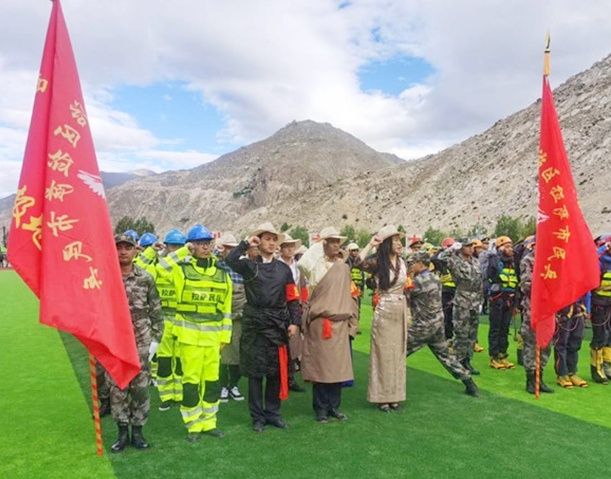
Two weeks earlier, the Tibet Daily announced that the Tibet Military District held a 'breaking record militia competition'.
Both Major General Thubten Thinley and Senior Colonel Ngawang Dorjee were in attendance. 'The competition requires that all personnel in the competition should be aware of the guiding ideology (Communism) to improve the level of their participation.'
'The exercises focus on changing the thinking mode of actual combat, to develop the ability to eliminate panic, and stimulate the training of the force, not only in regard to the battlefield, but also by treating the battle as a test.'
It concluded that the participants 'fully demonstrated superb skills and great style'. Ideological training is undoubtedly crucial.
The Tibet Military District has many senior Tibetan officers of the rank of colonels, senior colonels and major generals (never higher, as Communist China does not trust the Tibetans that much); but this gives a clear indication that the Tibetans will participate in future conflicts with India (in all probability, some were already present in Galwan).
It does not augur well for the relations between India and Tibet.
What will be the Tibetan government in exile's stand when it realises what is happening?
As nobody in India would like to have a deadly fight with Tibetan soldiers and officers, the issue needs to be closely followed.
Scenes from the Tibet Military District event:
Claude Arpi is a regular contributor to Rediff.com.
Feature Production: Rajesh Alva/Rediff.com







